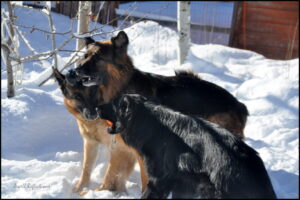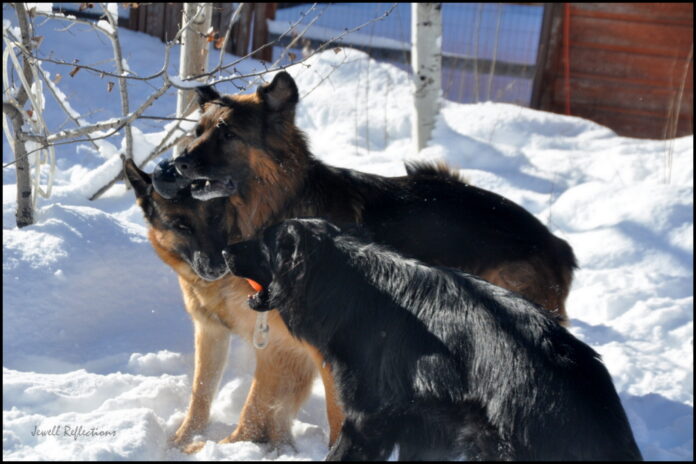By Fran Jewell
 Dogs display so many behaviors that are simply enchanting to watch. I spend every day watching dog behavior because it is so fascinating to me. I see their feelings, their hierarchy, and their distinct personalities. As an instructor and trainer, this is critical to helping dog owners to understand their own dogs. I also spend a lot of time photographing these behaviors.
Dogs display so many behaviors that are simply enchanting to watch. I spend every day watching dog behavior because it is so fascinating to me. I see their feelings, their hierarchy, and their distinct personalities. As an instructor and trainer, this is critical to helping dog owners to understand their own dogs. I also spend a lot of time photographing these behaviors.
One of my favorite behaviors is called “splitting”; it is done by the “peacemaker” of a group of dogs. It is usually the dog that is neither high in rank nor low in social rank. The peacemaker is usually right in the middle.
There are many that do not believe in social rank in the dog world, but to understand how dogs think, one must accept that in every species on the planet there is a social rank, even among dogs. To understand splitting, that acceptance of social rank is important.
I re-discovered this photograph recently and realized what a wonderful capture it is, especially looking at the dogs involved. On the left is my Brinx. He is what I call the “high-ranking male.” He is rather passive, clear, decisive, and every new dog that comes to my house will try to establish a relationship with him first. They will test his authority. They will see if he is playful or serious. As I see it, this is the new dog’s attempt to figure out where they are socially in the group. Brinx doesn’t need to fight. It’s like he has a general uniform on that all dogs recognize. Sometimes, just a lip curl is all he needs to establish himself with a visitor. And sometimes he just stands up when a puppy tries to mount him. He is a benevolent leader. A true high-ranking dog does not need to fight to establish position.
Kalidor, my black, long-coat German shepherd, tried his best when he turned a year old to challenge Brinx, to see if he could climb the social ladder. In the photo here, he is trying to be the dog that wins the toy. Winning a possession is important to young lads trying to establish themselves higher in social rank.
What is interesting is that Baewulf, the black-and-red, long-coat German shepherd, barges between Brinx and Kalidor hoping to force the interaction to stop. This behavior is called splitting. In this particular case, Baewulf did not stop the interaction, but he did make it clear his discontent with the struggle. It further told me the determination of Brinx and Kalidor, and just how strong and confident each of their personalities was.
Until Brinx left this good earth, Kalidor and Brinx had a mutual respect for each other. Baewulf kept an eye on their interactions, ready to intervene if needed. He was the peacemaker in my group. And without him, Brinx and Kalidor could have had more challenges with each other. His role was imperative to the peace and contentment of my pack of dogs.
Now that Brinx and Baewulf are gone, Kalidor has assumed the role of high-ranking male and in my pack the peacemaker is Pele. She will split interactions with newcomers to help the young one, Daenera, in her place.
Fran Jewell is an IAABC Certified Dog Behavior Consultant, NADOI Certified Instructor and the owner of Positive Puppy Dog Training, LLC in Sun Valley. For more information, visit positivepuppy.com or call 208-578-1565.



